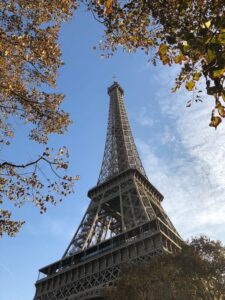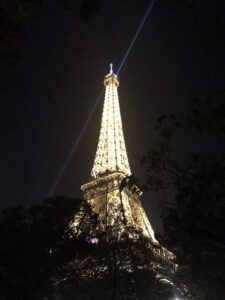That summer we arrived in Paris like we owned the place. At 15, that’s how you feel. Especially when you’ve left your own country for the first time and had a taste of freedom that can never be reversed. In London we ordered chalices of beer and no one blinked. In Paris we bought cigarettes, asking and offering strangers for a light as though we were seasoned smokers.
We learned to say “Je ne compras pas Francais” as though not knowing how to say we don’t speak the language was supposed to impress people. We joined all the tours—Notre Dame, the Louvre, the Bateaux Mouches (pronounced ba-tow moosh)—but then we had hours to do as we pleased, as long as we returned to the hotel by curfew. Which sometimes we didn’t and our Latin teacher who organized and chaperoned the whole thing would curse us.
I remember one time we pissed him off so much he didn’t speak to us for the entire time we were in Italy. We still respected him though (in Latin class he’d tell us stories of escaping the Nazis during the Hungarian Revolution and how he’d been an Olympic diver in Hungary) and he never seemed to take it out on me when I took third year Latin the following year.
Now—like a strange cool dream I return to Paris with my husband. I’m turning 50 in the City of Lights and I want to spend just a day here en route to Barcelona, to finish something I never started: going up the Eiffel Tower. In 1984 I remember standing beneath it with my friends and groaning at the idea of waiting in lines to go up some stupid tower. We were such assholes.
On the other hand, I soaked up so much of what Europe had to offer, it forever changed me and broadened my perspective for years to come. It certainly made me more worldly, more articulate about places and people. And pretty savvy for a smalltown girl. Not to mention, the genie was out of the bottle, so to speak. I could never be reeled in again by my mother. (Sorry mom. I know it was hell.)


The Eiffel Tower line is worth the wait
After checking into Hotel Plaza Opera and appreciating the balcony view of the Eiffel Tower we rush to get a bus to the tower for 5:30 p.m. timed ticketing. The goal is to get to the top by sunset around seven. As you approach the entrance, the street hawkers flash arms hung with Eiffel Tower souvenirs of all sizes and colors: gold, beige, black, and a flashing lights version that seems just too cheesy until you experience being up the tower with the dancing lights and realize it’s actually a pretty accurate representation.
We save our attention and our euros for later and make our way to the queue⏤still an hour-long wait to finally get to the front of the line and onto one of the elevators that takes you diagonally up the side of the tower to the first or second level. At the second level we get off, desperate for a coffee and a snack after nonstop travel, then proceed to the elevator that takes you to the summit.
From atop the Eiffel Tower Paris is aglow with perfection in urban engineering. Golden lights connect the dots of buildings and streets that form neat geometric angles. The Bateaux Mouches casts blue light as it glides effortlessly along the river Seine. Lighted bridges span the river like tiny golden rails meticulously placed to finish off a masterpiece. Two powerful spotlights shine from different angles at the very top of the tower, casting bright yellow light on key monuments below.
Families gaggle and lovers kiss, as thousands before them have over the last 129 years since the Eiffel Tower was built for the World Exposition in 1889. Gustav Eiffel’s application won and he was commissioned to build the tower. It took more than two years and a hundred workers and was an instant hit at the expo and for the city of Paris. At the time, it was the largest building on earth⏤a grand testament to Industrial Revolution prowess.

The Eiffel Tower during World War II
Miraculously the Eiffel Tower was spared during World War II although the German occupation of Paris meant a giant “V” banner (adopting the Allies’ use of “victory”) and German slogan underneath: “Germany is victorious on all fronts.”
In an act of rebellion, the French cut the cables on the tower lifts so that Hitler would have to take the steps if he wanted to go up the tower. Apparently, he never did. And as the end of the war neared, and perhaps as desperate declaration, Paris and all its historical and religious monuments were to be demolished though it never happened thanks to the German general who saw it as an act in futility and knew well by then that Hitler was a looney tune.
After we descend we make our way to the street vendors, trying to decide which version of the Eiffel Tower we should take home to our kids⏤the black one, the beige one, or the gilded one. It occurs to me that the “iron lady” may in fact look like any one of these colors at a given time of day. I always had it that it was just black, but tonight I’ve seen it a flat tan color when we arrive by daylight, turn to a darker beige then to a brilliant gold flickering into the night.
Who knew?
As expected, Paris surprises and delights.




